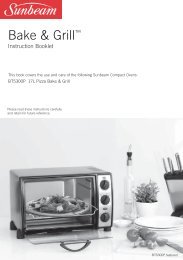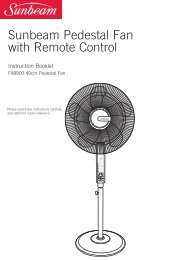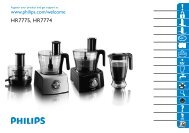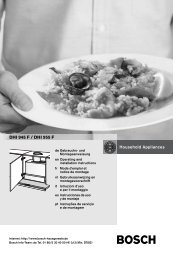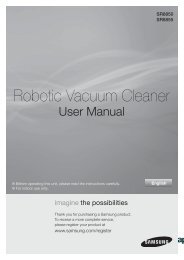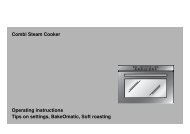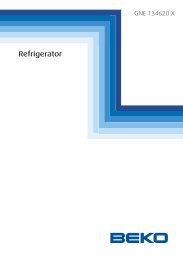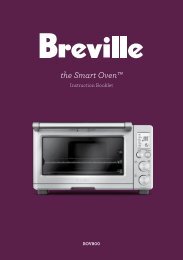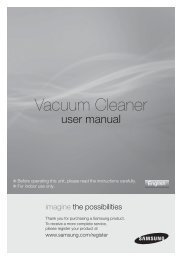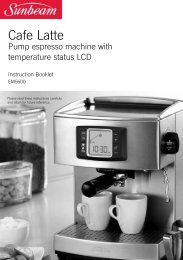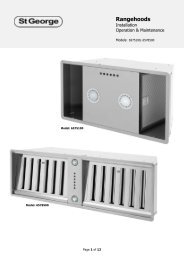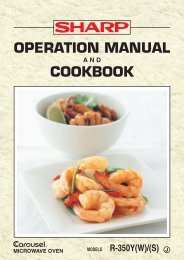Built-in Oven Operating Instructions & Recipe Manual - manuals ...
Built-in Oven Operating Instructions & Recipe Manual - manuals ...
Built-in Oven Operating Instructions & Recipe Manual - manuals ...
Create successful ePaper yourself
Turn your PDF publications into a flip-book with our unique Google optimized e-Paper software.
<strong>Built</strong>-<strong>in</strong> <strong>Oven</strong> Operat<strong>in</strong>g<br />
<strong>Instructions</strong> & <strong>Recipe</strong> <strong>Manual</strong>
YOUR FREE MASTERCLASS<br />
Although we encourage you to dive right <strong>in</strong>, as the owner of a brand new ILVE oven we’d also<br />
like to <strong>in</strong>vite you to attend a complimentary 2 hour masterclass. As part of the class you’ll<br />
learn how to prepare and cook a number of delicious signature ILVE dishes, not to mention<br />
our top tips for gett<strong>in</strong>g the most out of your ILVE oven. From improv<strong>in</strong>g cook<strong>in</strong>g results to<br />
general ma<strong>in</strong>tenance <strong>in</strong>formation, we know you’ll enjoy this comprehensive, fun masterclass.<br />
Simply go to ilve.com.au/book<strong>in</strong>gs or Phone 1300 MY ILVE (694 583)<br />
ilve.com.au
OPEN 24/7<br />
ILVE ACCESSORIES ONLINE SHOP<br />
For a wide range of coffee mach<strong>in</strong>es, pods and other ILVE<br />
accessories, at the click of a button shop.ilve.com.au
Congratulations,<br />
you are now the proud owner of an ILVE cook<strong>in</strong>g appliance.<br />
Thank you for purchas<strong>in</strong>g ILVE and welcome to the excit<strong>in</strong>g<br />
world of cook<strong>in</strong>g the ILVE way.<br />
This recipe book and <strong>in</strong>struction manual has been specially<br />
created to <strong>in</strong>form you of the full range of features your ILVE<br />
appliance has to offer and serves as an <strong>in</strong>troduction to the<br />
wonderful benefits of ILVE’s dynamic cook<strong>in</strong>g systems.<br />
In section one, we present detailed <strong>in</strong>formation on each of<br />
the advanced cook<strong>in</strong>g systems built <strong>in</strong>to ILVE appliances.<br />
Once you have read this section you will be able to choose<br />
the most appropriate sett<strong>in</strong>gs for your oven or cooktop<br />
when cook<strong>in</strong>g different types of food. Also, if you’re stuck<br />
for ideas, section two has many delicious recipes that show<br />
you how to get the most out of your ILVE appliance.
Contents<br />
Installation Check 8<br />
Rack Positions 9<br />
Burn<strong>in</strong>g <strong>in</strong> Elements 9<br />
Prepar<strong>in</strong>g Your <strong>Oven</strong> For Use 9<br />
<strong>Oven</strong> Systems 10<br />
Electric <strong>Oven</strong> Cook<strong>in</strong>g Modes 11<br />
Pre-Heat<strong>in</strong>g Your <strong>Oven</strong> 12<br />
<strong>Oven</strong> Roast<strong>in</strong>g Probe 12<br />
Cook<strong>in</strong>g With ILVE 13<br />
Roast<strong>in</strong>g 13<br />
Us<strong>in</strong>g Your Rotisserie 13<br />
Grill<strong>in</strong>g Systems 14<br />
Grill<strong>in</strong>g guide 15<br />
Gas <strong>Oven</strong> 16<br />
Clocks & Timers Controls 18<br />
Clean<strong>in</strong>g, Care & Ma<strong>in</strong>tenance 20<br />
Warranty Card 34<br />
Troubleshoot<strong>in</strong>g 39<br />
ILVE <strong>Recipe</strong>s 24<br />
• Tasmanian Scallops Creole Style<br />
• Rosemary Damper<br />
• Mustard Crusted Roast Leg of Lamb<br />
• Gourmet Pizza<br />
• Lemon Curd Tart<br />
• Hazelnut Torte with Chocolate Ganache<br />
• Panna Cotta<br />
ILVE Operat<strong>in</strong>g <strong>Manual</strong><br />
7
Installation Warn<strong>in</strong>gs<br />
SAFETY PRECAUTIOnS<br />
Before <strong>in</strong>stall<strong>in</strong>g and operat<strong>in</strong>g the cook<strong>in</strong>g range, read these <strong>in</strong>structions completely and carefully.<br />
IMPORTANT - To be <strong>in</strong>stalled only by an authorized person<br />
• Save these <strong>in</strong>structions for the local <strong>in</strong>spectors use.<br />
• Remove all packag<strong>in</strong>g material and literature from the hotplate<br />
• before connect<strong>in</strong>g the gas and electrical supplies. Additionally note that the correct wok trivet must be placed over the<br />
Wok burner. The wok burner trivet has a greater gap between the f<strong>in</strong>gers.<br />
• INSTALLATION – Observe all govern<strong>in</strong>g codes e.g. ASNZS 5601, council ord<strong>in</strong>ances and local authority rules.<br />
• The range must be <strong>in</strong>stalled by an authorised person<br />
• The range must be electrically grounded<br />
TO THE INSTALLER – after connect<strong>in</strong>g the gas supply, turn on the gas and check for leaks at all jo<strong>in</strong>ts with soapy water or<br />
other approved methods<br />
UNDER NO CIRCUMSTANCES USE A NAKED FLAME IN CHECKING FOR LEAKS<br />
NOT FOR USE IN MARINE CRAFT, CARAVANS OR MOBILE HOME UNLESS EACH BURNERS IS FITTED WITH A FLAME<br />
SAFE GUARD<br />
OPERATInG InSTRUCTIOnS<br />
WARnInGS<br />
Before us<strong>in</strong>g the cooker, read the <strong>in</strong>structions booklet carefully. This conta<strong>in</strong>s very important <strong>in</strong>formation concern<strong>in</strong>g safety dur<strong>in</strong>g<br />
<strong>in</strong>stallation, use and ma<strong>in</strong>tenance. The <strong>in</strong>structions booklet must be kept with care for later consultation.<br />
Do not use or store flammable materials <strong>in</strong> the appliance storage drawer or near this appliance.<br />
Do not spray aerosols <strong>in</strong> the vic<strong>in</strong>ity of this appliance when it is <strong>in</strong> operation.<br />
Where this appliance is <strong>in</strong>stalled <strong>in</strong> a mar<strong>in</strong>e craft or <strong>in</strong> caravans, it shall not be used as a space heater.<br />
Do not modify this appliance.<br />
If the hotplate fails to operate correctly, contact Eurol<strong>in</strong>x Pty ltd or their appo<strong>in</strong>ted agent for service.<br />
DO NOT ATTEMPT REPAIRS YOURSELF; repairs and servic<strong>in</strong>g shall only be carried out by Authorised Personnel.<br />
This appliance is not <strong>in</strong>tended for use by persons (<strong>in</strong>clud<strong>in</strong>g children) with reduced physical, sensory or mental capabilities, or<br />
lack of experience and knowledge, unless they have been given supervision or <strong>in</strong>struction concern<strong>in</strong>g use of the appliance by a<br />
person responsible for their safety.<br />
Children should be supervised to ensure that they do not play with the appliance.<br />
never place unsteady or deformed pans on the burners or on the electric hotplates as they could overturn accidentally. When<br />
plac<strong>in</strong>g pans on the hob, always ensure that the handles are fac<strong>in</strong>g <strong>in</strong>ward so that there is no risk of knock<strong>in</strong>g aga<strong>in</strong>st them.<br />
When the cooker is not <strong>in</strong> use, ensure that all knobs are exactly <strong>in</strong> position “• / º”<br />
never leave the hotplate switched on without a pan on it, otherwise it will reach a very high temperature quickly and the cooker or<br />
furniture <strong>in</strong> the vic<strong>in</strong>ity could be damaged.<br />
8 ILVE Operat<strong>in</strong>g <strong>Manual</strong>
Installation<br />
ILVE stoves, wall ovens and cooktops feature many advanced<br />
cook<strong>in</strong>g components and safety ref<strong>in</strong>ements. However before<br />
us<strong>in</strong>g your oven for the first time the follow<strong>in</strong>g <strong>in</strong>stallation<br />
check must be carefully carried out and oven elements must<br />
be burnt <strong>in</strong>.<br />
• Check that your ILVE <strong>in</strong>staller has screwed the oven <strong>in</strong>to its<br />
cavity and that all packag<strong>in</strong>g is removed from <strong>in</strong>side oven.<br />
• Check that all oven racks are <strong>in</strong> place.<br />
Burn<strong>in</strong>g <strong>in</strong> elements<br />
It is necessary to burn the protective oils that are used <strong>in</strong><br />
manufactur<strong>in</strong>g and shipp<strong>in</strong>g from the elements.<br />
1 Set the clock to the correct time. Refer to page 18.<br />
2 Remove the grill tray and set oven temperature control<br />
knob to 200º C and select cook<strong>in</strong>g function mode 2 by<br />
turn<strong>in</strong>g function control knob.<br />
3 Allow to burn <strong>in</strong> for 10 to 15 m<strong>in</strong>utes.<br />
4 Repeat process for functions 5 and 8 <strong>in</strong> sequence and<br />
allow to burn <strong>in</strong> each mode for 10 to 15 m<strong>in</strong>utes.<br />
5 Wipe the base of the oven once complet<strong>in</strong>g the burn <strong>in</strong><br />
process so that the oven and grill/rotisserie will be ready for<br />
use. Refer to page 22.<br />
• There may be a slight unpleasant odour dur<strong>in</strong>g the <strong>in</strong>itial<br />
burn off procedure. As a result we advise you open doors<br />
and w<strong>in</strong>dows <strong>in</strong> the kitchen dur<strong>in</strong>g this procedure.<br />
Electric<br />
Prepar<strong>in</strong>g your electric<br />
oven for use:<br />
Sett<strong>in</strong>g the clock<br />
To enable use of your ILVE oven you<br />
must first set the clock to the correct<br />
time. If the clock is not set correctly the<br />
oven will not operate (See page 24)<br />
Us<strong>in</strong>g the oven<br />
When us<strong>in</strong>g your ILVE oven you must<br />
select, us<strong>in</strong>g separate knobs, both a<br />
mode of cook<strong>in</strong>g and a temperature<br />
at which to cook. The only exception<br />
to this rule is when us<strong>in</strong>g the defrost<br />
mode, where no temperature sett<strong>in</strong>g<br />
is required.<br />
Temperature is <strong>in</strong>dicated by an<br />
ORAnGE light. This light will turn<br />
on and off dur<strong>in</strong>g cook<strong>in</strong>g as the<br />
thermostat readjusts itself.<br />
Cook<strong>in</strong>g mode selection is <strong>in</strong>dicated by<br />
a GREEn light. This light should stay<br />
on throughout the cook<strong>in</strong>g process.<br />
All ILVE ovens are fitted with a cavity<br />
cool<strong>in</strong>g fan. This fan is thermostatically<br />
controlled and automatically switches<br />
on when the oven cavity reaches 60ºC.<br />
This gently blows air out through the<br />
front louvre just above the oven door<br />
handle, reduc<strong>in</strong>g outside heat. This<br />
fan will cont<strong>in</strong>ue to operate for a short<br />
period of time after you stop us<strong>in</strong>g the<br />
oven<br />
Temperature<br />
ILVE ovens are well <strong>in</strong>sulated and<br />
therefore highly efficient; as a result we<br />
recommend you may have to adjust<br />
cook<strong>in</strong>g temperatures. In an ILVE<br />
oven a moderate to hot temperature is<br />
175ºC. You will f<strong>in</strong>d this temperature<br />
will not need to be exceeded, except<br />
for specific cook<strong>in</strong>g requirements<br />
which call for high heat over a short<br />
period of time. Exceed<strong>in</strong>g 175ºC when<br />
cook<strong>in</strong>g may result <strong>in</strong> food cook<strong>in</strong>g too<br />
quickly on the outside while rema<strong>in</strong><strong>in</strong>g<br />
undercooked <strong>in</strong>side. Remember to<br />
reduce the temperature by 20ºC when<br />
us<strong>in</strong>g the fan forced function.<br />
ILVE Operat<strong>in</strong>g <strong>Manual</strong><br />
9
<strong>Oven</strong> Systems<br />
All ILVE electric ovens are multifunctional and feature up to eleven cook<strong>in</strong>g modes. This enables you<br />
to choose from a variety of functions depend<strong>in</strong>g on your cook<strong>in</strong>g needs. Selection of the correct mode<br />
and oven temperature are important to obta<strong>in</strong> the best possible cook<strong>in</strong>g results. All modes are pictured<br />
on your control knob and are numbered clockwise.<br />
ILVE electric ovens are equipped with rear, top and bottom elements, which can be used <strong>in</strong>dividually or<br />
together; radiat<strong>in</strong>g heat from above and below simultaneously or <strong>in</strong>dividually for specialist tasks such<br />
as au grat<strong>in</strong> style cook<strong>in</strong>g, crisp<strong>in</strong>g pork crackl<strong>in</strong>g or to brown off a roast.<br />
The ILVE electric oven also has a quick start or preheat mode which allows the oven to heat from<br />
0 –175ºC <strong>in</strong> just 6 to 8 m<strong>in</strong>utes.<br />
Cavity cool<strong>in</strong>g fan<br />
ILVE ovens are equipped with a cavity cool<strong>in</strong>g fan. The fan is thermostatically controlled and will<br />
switch on automatically when the oven cavity reaches a temperature of 60º C. Air will gently be<br />
blown out through the front louvre, just above the oven door handle. This keeps the <strong>in</strong>terior of the<br />
cavity hous<strong>in</strong>g cool.<br />
The cavity cool<strong>in</strong>g fan will cont<strong>in</strong>ue to run after the oven has been turned off. The fan will automatically<br />
shut off once the oven cavity has reached a suitable temperature.<br />
10 ILVE Operat<strong>in</strong>g <strong>Manual</strong>
Electric <strong>Oven</strong> Cook<strong>in</strong>g Modes<br />
ICON MODE FUNCTION<br />
MODE 1<br />
Pizza mode<br />
MODE 2<br />
Conventional oven<br />
mode<br />
MODE 3<br />
Lower floor heat<strong>in</strong>g<br />
mode<br />
MODE 4<br />
Upper element<br />
mode<br />
MODE 5<br />
Conventional Grill<strong>in</strong>g<br />
mode<br />
Rotisserie mode<br />
(All models except<br />
600mm and P70<br />
Series ovens)<br />
MODE 6<br />
Fan Grill<br />
MODE 7<br />
Fan Assist<br />
MODE 8<br />
Fan Forced<br />
MODE 9<br />
Quick Start<br />
or Pre-heat mode<br />
MODE 10<br />
Defrost mode<br />
Roast<strong>in</strong>g probe<br />
(For models 948<br />
Series, 600SSXMP &<br />
Majestic Series only)<br />
ILVE’s unique Pizza mode has been specifically designed for you to cook the perfect Pizza<br />
To achieve perfect results; turn the oven thermostat up to 250 degrees (best temperature<br />
for pizza cook<strong>in</strong>g) ILVE’s pizza mode will do the rest by turn<strong>in</strong>g on all elements <strong>in</strong> the oven<br />
at 30% and the bottom element on at 100% of their capacity. This ensures you get a<br />
nice crispy base with the assistance of the other elements at lower heat to cook the top<br />
of your pizza. For best results it is recommended that ILVE’s pizza stone be used on the<br />
second shelf when us<strong>in</strong>g this function.<br />
This is the traditional static oven mode with no fan allow<strong>in</strong>g heat from both above and<br />
below to convect simultaneously. This is the ideal function for cook<strong>in</strong>g heavy cakes such<br />
as mud cakes or banana cakes, Christmas cakes, breads and large roasts. Such items<br />
need to be placed on shelf number 2.<br />
This mode allows heat from the base of the oven. It is suitable for long, slow<br />
cook<strong>in</strong>g such as stews and casseroles or for bl<strong>in</strong>d bak<strong>in</strong>g and f<strong>in</strong>ish<strong>in</strong>g pastries.<br />
In this mode the upper outer element is <strong>in</strong> use. This permits ‘Au Grat<strong>in</strong>’ style cook<strong>in</strong>g for a<br />
firm crust.<br />
In this mode the complete <strong>in</strong>ner roof element heats up creat<strong>in</strong>g direct <strong>in</strong>fra-red heat from<br />
above. With this mode you should grill with the door closed.<br />
The rotisserie mode works <strong>in</strong> a similar way as traditional grill<strong>in</strong>g and is one of the best<br />
ways to cook meat and poultry. With a right hand side motor drive <strong>in</strong> the oven, or <strong>in</strong> the<br />
rear of the 300mm & 400mm ovens. The ILVE rotisserie can accommodate up to two<br />
jo<strong>in</strong>ts of meat or portions of poultry at once.<br />
This mode utilises the fan comb<strong>in</strong>ed with the <strong>in</strong>fra-red grill to ensure hot air is circulated<br />
evenly around the oven. This is the ideal mode to use when multitask<strong>in</strong>g, grill<strong>in</strong>g chops<br />
and sausages on the top level whilst bak<strong>in</strong>g a potato bake on the lower level. The door<br />
should be closed dur<strong>in</strong>g this grill<strong>in</strong>g mode.<br />
With both the top and bottom elements <strong>in</strong> use and the fan circulat<strong>in</strong>g hot air,<br />
this cook<strong>in</strong>g mode is best suited for bread, cakes, pastries and sponges, where very even<br />
temperatures are required, even <strong>in</strong> the corners of the oven.<br />
This mode also creates less splatter when roast<strong>in</strong>g.<br />
The fan <strong>in</strong> all ILVE ovens is surrounded by a triple r<strong>in</strong>g heat<strong>in</strong>g element that<br />
evenly distributes heated air throughout the oven. This mode is perfect for batch bak<strong>in</strong>g<br />
biscuits or muff<strong>in</strong>s and most general cook<strong>in</strong>g tasks. IMPORTANT – Ensure you reduce the<br />
temperature by 20°C. Mode 8 is also the self-clean<strong>in</strong>g mode <strong>in</strong> models, which have self<br />
clean<strong>in</strong>g l<strong>in</strong>ers.<br />
To obta<strong>in</strong> the best result from your oven it is recommended that you preheat it prior to<br />
use. Comb<strong>in</strong><strong>in</strong>g an advanced hot air function and conventional heat<strong>in</strong>g mode ILVE ovens<br />
can reach a temperature of 175°C <strong>in</strong> just 6 – 8 m<strong>in</strong>utes. Once preheated the required<br />
cook<strong>in</strong>g mode should be selected before proceed<strong>in</strong>g with cook<strong>in</strong>g.<br />
This function allows you to fan defrost at an ambient temperature.<br />
Unlike defrost<strong>in</strong>g us<strong>in</strong>g your microwave this mode does not dry or par-cook food.<br />
Some ILVE models are equipped with a microprocessor controlled roast<strong>in</strong>g probe which<br />
can be used to cook roasts to a precise f<strong>in</strong>ish either rare, medium or well-done, tak<strong>in</strong>g the<br />
guess work out of cook<strong>in</strong>g.<br />
Please note: To turn the oven light on or off dur<strong>in</strong>g cook<strong>in</strong>g,<br />
simply push <strong>in</strong> the oven control knob.<br />
ILVE Operat<strong>in</strong>g <strong>Manual</strong><br />
11
Electric <strong>Oven</strong> Cook<strong>in</strong>g Modes<br />
Preheat<strong>in</strong>g<br />
Always preheat your ILVE oven to at<br />
least 175ºC before plac<strong>in</strong>g food <strong>in</strong> it.<br />
To do this use the Quick Start mode<br />
(Mode 9) on your control knob.<br />
Set your oven to 175ºC, after the oven<br />
has reached temperature, <strong>in</strong>dicated<br />
by the temperature light turn<strong>in</strong>g off,<br />
you may then switch the oven to your<br />
required mode.<br />
Roast<strong>in</strong>g Probe<br />
ILVE’s premium models are equipped<br />
with a microprocessor controlled roast<strong>in</strong>g<br />
probe which can be used to cook<br />
roasts to a precise f<strong>in</strong>ish. The probe is<br />
thermostatic and is <strong>in</strong>serted <strong>in</strong>to the<br />
thickest part of the roast away from<br />
the bone. When the probe is fitted to<br />
the connection po<strong>in</strong>t, the thermometer<br />
activates. By press<strong>in</strong>g the + or – buttons<br />
you can program the probe to the<br />
Electric <strong>Oven</strong> Function Selection<br />
FUNCTION<br />
TYPE OF FOOD<br />
Pizza •<br />
PIZZA DEFROST ADVANCED<br />
HOT AIR<br />
desired temperature for the roast (to<br />
reset remove the probe from oven).<br />
How To Use The<br />
Roast<strong>in</strong>g Probe<br />
Before putt<strong>in</strong>g the meat <strong>in</strong>to<br />
the oven, <strong>in</strong>sert the sharp end<br />
of the probe <strong>in</strong>to the centre of<br />
your cut of meat be<strong>in</strong>g sure to<br />
keep away from any bones as this will<br />
give a false read<strong>in</strong>g to the temperature<br />
detector. Then <strong>in</strong>sert the other end of<br />
the probe <strong>in</strong>to the connection po<strong>in</strong>t at<br />
the top right hand corner of your over,<br />
you will notice your display now shows<br />
two sets of numbers – the numbers on<br />
the left represent the meat at that time,<br />
the numbers on the right represent the<br />
desired temperature you would like the<br />
meat to be at the end of cook<strong>in</strong>g. To<br />
alter this, press the + or – buttons until<br />
you get the desired temperature.<br />
FAN<br />
ASSIST<br />
FAN<br />
GRILL CONVENTIONAL<br />
GRILL SYSTEM UPPER<br />
ROOF<br />
ELEMENT<br />
Roast<strong>in</strong>g guide:<br />
• Rare 60ºC<br />
• Medium 70ºC<br />
• Well-Done 80ºC<br />
If the meat is left <strong>in</strong> the oven an alarm<br />
will sound and the oven will turn<br />
off when the desired temperature<br />
is reached. Set the function and<br />
thermostst knobs to your desired<br />
sett<strong>in</strong>gs and your oven will do the rest.<br />
If you like you can also use the m<strong>in</strong>ute<br />
m<strong>in</strong>der whilst us<strong>in</strong>g this feature for<br />
multi-task<strong>in</strong>g.<br />
LOWER<br />
FLOOR<br />
ELEMENT<br />
CONVENTIONAL<br />
HEATING<br />
ROTISSERIE ROASTING<br />
PROBE<br />
Meat Roasts • • • • • • •<br />
Small Cuts • • • • •<br />
Steak/Sausages • •<br />
Whole Fish Fillets • • • • • •<br />
Poultry Whole<br />
Pieces • • • • • •<br />
Comb<strong>in</strong>ed Meats • • •<br />
Pastry Dishes –<br />
Pies, Quiche etc. • • •<br />
Egg Dishes –<br />
Souffle, Pavlova,<br />
etc.<br />
• •<br />
Bread • • •<br />
AuGrat<strong>in</strong>/Crumb<br />
Cheese • •<br />
Toasted<br />
Sandwiches<br />
•<br />
SHELF POSITIOn 2-3 AnY AnY 2-3 3-4 3-4 3-4 1-2 2-3 1 1-3<br />
12 ILVE Operat<strong>in</strong>g <strong>Manual</strong>
Cook<strong>in</strong>g with ILVE<br />
Roast<strong>in</strong>g<br />
The roast<strong>in</strong>g method is one of the<br />
simplest ways to cook a large piece<br />
of meat. Roast<strong>in</strong>g is often the method<br />
of choice because it yields a tender<br />
<strong>in</strong>terior and browned exterior through<br />
prolonged oven cook<strong>in</strong>g. One of the<br />
most attractive aspects of roast<strong>in</strong>g to<br />
a busy cook is that while the roast is<br />
cook<strong>in</strong>g, the cook is freed to perform<br />
any other tasks that need attention<br />
before d<strong>in</strong>ner is served. Before<br />
beg<strong>in</strong>n<strong>in</strong>g the oven cook<strong>in</strong>g segment<br />
of the roast<strong>in</strong>g process, the meat<br />
should be trimmed and seasoned.<br />
The standard temperature for cook<strong>in</strong>g<br />
roasts is 175ºC.<br />
Technically, the lower the heat of<br />
the oven, the better the f<strong>in</strong>al roasted<br />
product will be. At a lower temperature,<br />
the meat will take longer to cook but<br />
will produce more flavour and moisture.<br />
(never roast meat at a temperature<br />
below 93°C). Once the temperature to<br />
cook the roast at has been decided<br />
upon, and the oven preheated, place<br />
the trimmed, tied and seasoned meat<br />
onto a bak<strong>in</strong>g dish and <strong>in</strong>to the oven.<br />
Roast the meat until its ideal <strong>in</strong>ternal<br />
temperature is reached. The ideal<br />
<strong>in</strong>ternal temperature will depend wholly<br />
on what type of meat is be<strong>in</strong>g roasted.<br />
For example, a roast pork lo<strong>in</strong>’s f<strong>in</strong>al<br />
<strong>in</strong>terior temperature should be around<br />
70°C. Gauge the <strong>in</strong>ternal temperature<br />
of meat by us<strong>in</strong>g a meat thermometer<br />
or by us<strong>in</strong>g the ILVE Roast<strong>in</strong>g Probe<br />
(available on some models only).<br />
Rotisserie<br />
The rotisserie is one of the best ways<br />
to cook meat. The rotisserie can<br />
accommodate up to two jo<strong>in</strong>ts of<br />
meat or portions of poultry at once.<br />
Meat cooked this way will need<br />
approximately 40 to 50 m<strong>in</strong>utes per kilo<br />
at a temperature of 175 to 200°C. This<br />
is a guide only; it is recommended that<br />
meat is checked every 30 m<strong>in</strong>utes.<br />
1. Insert rotisserie skewer <strong>in</strong>to small<br />
open<strong>in</strong>g on right side of oven wall<br />
cavity.<br />
2. Leave oven door closed.<br />
3. Turn function knob to grill and set the<br />
temperature to 175°C.<br />
nOTE: The ILVE rotisserie motor has a<br />
weight load of 4kg for 30cm <strong>Oven</strong>, 6kg<br />
for the 40cm <strong>Oven</strong> and 8kg for all other<br />
ILVE ovens.<br />
• Refer to page 16 for cook<strong>in</strong>g<br />
methods <strong>in</strong> your gas oven.<br />
Pizza stone<br />
You can use the pizza stone for both<br />
pizzas and sweet pastries.<br />
The pizza stone can also be used for<br />
keep<strong>in</strong>g your bread warm and crusty,<br />
just buy a good loaf of bread, warm <strong>in</strong><br />
the oven and serve on the pizza stone.<br />
ILVE TIP<br />
After cook<strong>in</strong>g wipe the pizza stone<br />
with wet cloth, the blacker it gets the<br />
tastier the food will be, just like with<br />
wok cook<strong>in</strong>g and barbequ<strong>in</strong>g. If you<br />
are cook<strong>in</strong>g pasrties, you can lay<br />
bak<strong>in</strong>g paper over the stone to avoid<br />
flavours cross<strong>in</strong>g over.<br />
ILVE Operat<strong>in</strong>g <strong>Manual</strong><br />
13
Grill<strong>in</strong>g Systems Electric<br />
There are two ways to grill food <strong>in</strong> an ILVE electric oven;<br />
by us<strong>in</strong>g radiant heat to cook the food or by us<strong>in</strong>g thermal<br />
grill<strong>in</strong>g, a comb<strong>in</strong>ation of radiant heat with thermal air flow.<br />
The full roof area conventional grill system uses<br />
automatically controlled direct <strong>in</strong>fra-red heat radiated<br />
from above for traditional grill<strong>in</strong>g applications. ILVE ovens<br />
comb<strong>in</strong>e the advantages of <strong>in</strong>fra-red heat with fan forced<br />
air assistance, allow<strong>in</strong>g grill<strong>in</strong>g and bak<strong>in</strong>g on two different<br />
levels at the same time.<br />
Both cook<strong>in</strong>g techniques give exceptional results for a<br />
wide range of meat cuts such as chicken breasts, beef<br />
steaks, lamb and pork. It is also ideal for grill<strong>in</strong>g fish and<br />
fish fillets.<br />
MODE 5 Full roof area conventional<br />
grill<strong>in</strong>g mode<br />
In this mode the <strong>in</strong>ner roof element<br />
heats up creat<strong>in</strong>g direct <strong>in</strong>fra-red heat.<br />
This mode allows you to grill with the door<br />
closed. Grill<strong>in</strong>g with the door open ajar may<br />
lead to the control knob heat<strong>in</strong>g up slightly.<br />
MODE 6 Hot air grill<strong>in</strong>g system<br />
14 ILVE Operat<strong>in</strong>g <strong>Manual</strong><br />
This mode utilises the fan comb<strong>in</strong>ed with the<br />
<strong>in</strong>fra-red grill to ensure hot air is circulated<br />
evenly around the oven. This is the ideal<br />
mode to use when multitask<strong>in</strong>g, grill<strong>in</strong>g chops<br />
and sausages on the top level whilst bak<strong>in</strong>g<br />
a potato bake on the lower level. The door<br />
must be closed dur<strong>in</strong>g this grill<strong>in</strong>g mode.<br />
Traditional grill<br />
1. Select the grill mode (Mode 5) on the<br />
function control knob.<br />
2. Turn the temperature control knob to<br />
200º C.<br />
The oven heat<strong>in</strong>g <strong>in</strong>dicator light (orange<br />
light) at the front control panel comes<br />
on when the thermostat is activated<br />
and turns off once it has reached the<br />
selected temperature sett<strong>in</strong>g.<br />
ILVE Tip<br />
• When conventional grill<strong>in</strong>g<br />
the oven door should always<br />
be closed<br />
• The best sett<strong>in</strong>gs for<br />
conventional grill<strong>in</strong>g is<br />
between 175 – 190º C.<br />
• For best results, we<br />
recommend grill<strong>in</strong>g on level 4.<br />
Fan grill<strong>in</strong>g<br />
1. Position racks at heights accord<strong>in</strong>g<br />
to food types and thickness (See hot<br />
air grill cook<strong>in</strong>g guide)<br />
2. Select the fan grill mode (Mode 6) on<br />
the function control knob.<br />
3. Turn the temperature control knob to<br />
175º C.<br />
4. Allow oven to preheat for a m<strong>in</strong>imum<br />
of four m<strong>in</strong>utes depend<strong>in</strong>g on food<br />
types.<br />
When fan grill<strong>in</strong>g on multiple shelves<br />
the oven door must be closed. The<br />
grill element at the top of the oven<br />
produces <strong>in</strong>tense heat to sear the<br />
surface of the food while the fan moves<br />
this heat around the oven. Fan grill<strong>in</strong>g<br />
elim<strong>in</strong>ates the need to turn food over<br />
dur<strong>in</strong>g the grill<strong>in</strong>g process; however,<br />
turn<strong>in</strong>g is optional depend<strong>in</strong>g on the<br />
degree of brown<strong>in</strong>g desired. When us<strong>in</strong>g<br />
this function make sure that food is<br />
elevated to allow the hot air to circulate<br />
around the food. Food can be placed on<br />
the grill rack that sits <strong>in</strong>side the bak<strong>in</strong>g<br />
tray alternatively; food can be placed on<br />
a grill rack positioned over an oven pan<br />
to make sure any drips are caught.
ILVE Tip<br />
• The oven door should always<br />
be closed dur<strong>in</strong>g hot air grill<strong>in</strong>g.<br />
• The temperature should be<br />
set from 175 – 180º, this range<br />
<strong>in</strong> temperature helps prevent<br />
food from burn<strong>in</strong>g and avoids<br />
splatter, m<strong>in</strong>imis<strong>in</strong>g the need for<br />
clean<strong>in</strong>g.<br />
• The shelves are numbered 5 to<br />
1 from top to bottom<br />
(See diagram above right).<br />
Grill<strong>in</strong>g guide<br />
FOOD TO BE<br />
GRILLED<br />
THIn CUTS<br />
RECOM-<br />
MENDED<br />
SHELF<br />
POSITION<br />
OVEn<br />
TEMP<br />
TRADITIONAL<br />
GRILLING<br />
GRILLInG<br />
TIME 2<br />
OVEn<br />
TEMP<br />
IMPORTANT!<br />
Do not place anyth<strong>in</strong>g on or cover<br />
the base of oven as this impedes<br />
the transfer of heat from the bottom<br />
element to the oven cavity and can<br />
cause irreparable damage to the<br />
oven base.<br />
FAN GRILLING<br />
GRILLInG<br />
TIME 2<br />
Steaks 3 - 4 200ºC 10 - 16 m<strong>in</strong>s 175ºC 10 - 16 m<strong>in</strong>s<br />
Vegetable Kebabs 3 200ºC 15 - 20 m<strong>in</strong>s 175ºC 15 - 20 m<strong>in</strong>s<br />
Meat Kebabs 3 200ºC 15 - 20 m<strong>in</strong>s 175ºC 15 - 20 m<strong>in</strong>s<br />
Cutlets / Schnitzel 3 - 4 200ºC 12 - 18 m<strong>in</strong>s 175ºC 18 - 20 m<strong>in</strong>s<br />
Liver 3 - 4 200ºC 8 - 12 m<strong>in</strong>s 175ºC 10 - 14 m<strong>in</strong>s<br />
Burgers 3 - 4 200ºC 14 - 20 m<strong>in</strong>s 175ºC 16 - 20 m<strong>in</strong>s<br />
Sausages 3 - 4 200ºC 10 - 15 m<strong>in</strong>s 175ºC 8 - 12 m<strong>in</strong>s<br />
Fish Fillets 3 - 4 200ºC 12 - 16 m<strong>in</strong>s 175ºC 12 - 16 m<strong>in</strong>s<br />
Trout 3 - 4 200ºC 16 - 20 m<strong>in</strong>s 175ºC 20 - 25 m<strong>in</strong>s<br />
Toast 3 - 4 200ºC 2 - 4 m<strong>in</strong>s 175ºC 3 - 5 m<strong>in</strong>s<br />
Cheese Toast 3 - 4 200ºC 7 - 9 m<strong>in</strong>s 175ºC 4 - 6 m<strong>in</strong>s<br />
Tomatoes 3 - 4 200ºC 6 - 8 m<strong>in</strong>s 175ºC 6 - 8 m<strong>in</strong>s<br />
Peaches 3 200ºC 6 - 8 m<strong>in</strong>s 175ºC 7 - 10 m<strong>in</strong>s<br />
THICKER CUTS<br />
Shelf positions<br />
– 5<br />
– 4<br />
– 3<br />
– 2<br />
– 1<br />
Chicken (1kg) 2 – – 175ºC 50 - 60 m<strong>in</strong>s<br />
Rolled Meat (1kg) 1 – – 175ºC 75 - 85 m<strong>in</strong>s<br />
Pork (1kg) 1 – – 175ºC 100 - 120 m<strong>in</strong>s<br />
Sirlo<strong>in</strong> (1kg) 1 – – 200ºC 25 - 35 m<strong>in</strong>s<br />
1) Select the appropriate shelf level for the thickness of the food.<br />
2) Turn food over half way through the grill<strong>in</strong>g time.<br />
note: The <strong>in</strong>formation given <strong>in</strong> this chart is <strong>in</strong>tended as a guide only.<br />
ILVE Operat<strong>in</strong>g <strong>Manual</strong><br />
15
Gas <strong>Oven</strong>s<br />
There are upto five<br />
cook<strong>in</strong>g options available<br />
with ILVE gas ovens<br />
(depend<strong>in</strong>g on the oven size):<br />
1. Static Gas <strong>Oven</strong><br />
2. Fan Forced Gas <strong>Oven</strong><br />
3. Fan Grill<br />
4. Static Grill<br />
5. Rotisserie<br />
(80cm <strong>Oven</strong> Only)<br />
Cook<strong>in</strong>g <strong>in</strong> your<br />
gas oven<br />
There are 5 shelf levels <strong>in</strong> your oven.<br />
Level 1 is the bottom and level 5 is the<br />
top. The oven will not light unless the<br />
oven door is fully open.<br />
To turn on the gas oven, open the oven<br />
door and turn the thermostat knob (B)<br />
anti-clockwise to 250ºC and hold <strong>in</strong> for<br />
approximately 15 seconds. This will heat<br />
the thermocouple and allow the gas to<br />
flow through. (You do not need to use<br />
the knob (A) marked 1-12 at this stage.)<br />
You can tell that the oven is alight if you<br />
look through the small holes situated <strong>in</strong><br />
the base of the oven to see the flame.<br />
Once the flame is lit, the door must<br />
stay open for 3 m<strong>in</strong>utes (this ensures<br />
there is enough oxygen to keep the<br />
flame alight.) Then with the temperature<br />
knob (B) select the temperature<br />
required. Temperature range is from<br />
100°C – 250°C. To achieve 100°C<br />
on the temperature knob (not visibly<br />
marked), there is a section when you<br />
turn the knob (B) towards the off<br />
position where it won’t allow the knob<br />
to move/turn anymore without the knob<br />
be<strong>in</strong>g pressed <strong>in</strong> (which turns the oven<br />
off), and this is the 100°C gauge.<br />
To turn the light on <strong>in</strong>side the oven<br />
whist cook<strong>in</strong>g turn the Function knob<br />
(A) to the very first icon (square box<br />
with light picture and rotisserie) this will<br />
turn the light on. At this stage the oven<br />
is heat<strong>in</strong>g from the base (gas flames<br />
are under the removable floor).<br />
For most cook<strong>in</strong>g it is recommended to<br />
use shelf levels 2 or 3.<br />
16 ILVE Operat<strong>in</strong>g <strong>Manual</strong><br />
ILVE Tip<br />
• Cook<strong>in</strong>g with the electric grill must<br />
be carried out with the door of the<br />
oven closed.<br />
• The grill does not operate when the<br />
gas function of the oven is on.<br />
• It is advisable to preheat the grill for<br />
5 m<strong>in</strong>utes before putt<strong>in</strong>g food <strong>in</strong>.<br />
• Do not grill on the top level of the<br />
oven – for even grill<strong>in</strong>g cook on the<br />
second level from the top.<br />
To use the Fan Forced function <strong>in</strong> the<br />
gas oven, once you have closed the<br />
door turn the Function knob (A) past<br />
the number 12, you will feel a click and<br />
hear the fan activate. This is now Fan<br />
Forced Gas <strong>Oven</strong> mode.<br />
To turn off Fan Forced, turn the<br />
Function knob (A) back to the light<br />
icon. The benefit of Fan Forced Gas<br />
<strong>Oven</strong> is that the heat is distributed<br />
evenly through the whole oven. The<br />
rear fan circulates the air creat<strong>in</strong>g even<br />
temperatures <strong>in</strong>side the oven cavity.<br />
Fan Forced is most beneficial when<br />
do<strong>in</strong>g batch/multi level cook<strong>in</strong>g.<br />
Grill<strong>in</strong>g<br />
The Function knob (A) is for the grill<br />
function also. The grill is electric and<br />
will not work whilst the gas oven is<br />
on. To activate the grill turn knob<br />
(A) clockwise to number 8. This is<br />
equivalent to 180C. You can use the<br />
grill as a static grill (normal grill<strong>in</strong>g with<br />
radiant heat) or you can choose to<br />
have fan grill.<br />
Static Grill<br />
This is great for an <strong>in</strong>tense heat e.g.<br />
Cheese toast, oyster Kilpatrick, Crème<br />
Brule. Static grill cook<strong>in</strong>g use Level 4<br />
for the best results.<br />
Fan Grill<br />
This is great for cook<strong>in</strong>g meat e.g. –<br />
skewers, sausages, cutlets and chicken<br />
pieces (w<strong>in</strong>gs and drumsticks.) On this<br />
function there is no need to turn the<br />
foods, the grill will brown the top of<br />
the food and the hot air which is be<strong>in</strong>g<br />
circulated by the rear fan, will cook it<br />
from the underside, lock<strong>in</strong>g <strong>in</strong> the juices<br />
and keep<strong>in</strong>g the heat <strong>in</strong>side the oven. To<br />
activate the fan grill, turn knob (A) past<br />
the number 12 until you hear a click.<br />
This has activated the fan. Then turn<br />
the knob back to number 8 which is the<br />
best temperature for fan grill<strong>in</strong>g. Keep<br />
the door closed when us<strong>in</strong>g fan grill.<br />
Rotisserie<br />
This is done on the static grill function.<br />
The rotisserie can weight bear up to<br />
8kg. Skewer your desired meats onto<br />
the rotisserie rod and secure <strong>in</strong> place<br />
with the forks. Set up bak<strong>in</strong>g tray<br />
(black tray) with the rotisserie cradle,<br />
this goes <strong>in</strong>to level 1. Place meat <strong>in</strong>side<br />
oven and turn Function knob (A) to 12<br />
for the first 8 m<strong>in</strong>utes. This helps to<br />
ensure the sk<strong>in</strong> will seal and lock <strong>in</strong><br />
juices. After the 8 m<strong>in</strong>utes, turn down<br />
to number 6 or 7.<br />
When the meat is cooked, remove from<br />
oven and allow to rest before carv<strong>in</strong>g. If<br />
you wish to cook your roast potatoes,<br />
put them <strong>in</strong> the oven at the same time<br />
as the meat. They will take longer to<br />
cook compared to normal roast<strong>in</strong>g.<br />
Whilst the meat is rest<strong>in</strong>g, you may want<br />
to brown off the potatoes if desired. To<br />
do this, move the bak<strong>in</strong>g dish to level 4,<br />
turn function knob (A) to 9 and grill for<br />
5 m<strong>in</strong>utes or until browned.<br />
*nOTE: the electric grill will not work<br />
whilst the gas oven is <strong>in</strong> use.<br />
TYPE OF FOOD GRILL OVEn ROTIS-<br />
SERIE SHELF<br />
Meat Roasts • • 2-3<br />
Small Cuts • 4<br />
Steak/Sausages • 3-4<br />
Whole Fish Fillets • • 3<br />
Poultry Whole Pieces • • • 3<br />
Comb<strong>in</strong>ed Meats • 3-4<br />
Pastry Dishes –<br />
Pies, etc. • 2<br />
Egg Dishes – Quiche,<br />
Souffle, Pavlova, etc. • 2-3<br />
Bread & Pizza • 2<br />
AuGrat<strong>in</strong>/Crumb<br />
Cheese<br />
•<br />
3-4<br />
Toasted Sandwiches • 3-4
(A)<br />
Function knob<br />
Cook<strong>in</strong>g In Your ILVE Gas <strong>Oven</strong><br />
An ILVE fan forced gas oven has the<br />
base burner situated under the oven<br />
floor. The advantage of ILVE’s fan<br />
forced gas oven is that the heat is<br />
distributed evenly throughout, which<br />
makes it ideal for batch bak<strong>in</strong>g.<br />
However, the lower shelf is the<br />
hottest when bak<strong>in</strong>g so experiment<br />
with different shelf positions to obta<strong>in</strong><br />
the best results.<br />
The thermostat <strong>in</strong> ILVE gas ovens is<br />
mechanical; it operates on a different<br />
system than electric ovens. There<br />
is no <strong>in</strong>dicator light on the front of<br />
the panel of the upright to show<br />
you when the oven has reached<br />
the correct temperature, however<br />
the gas oven heats up fairly quickly<br />
due to the powerful gas burner at<br />
the base of the oven. A moderate<br />
to hot temperature <strong>in</strong> gas ovens is<br />
175°C. You cannot switch between<br />
the mode of cook<strong>in</strong>g <strong>in</strong> the gas oven<br />
like you can <strong>in</strong> the electric – if you are<br />
cook<strong>in</strong>g on the fan forced and then<br />
wish to use the grill then you must<br />
start aga<strong>in</strong> and activate the electric<br />
grill element.<br />
Cakes<br />
Cook cakes on the third shelf<br />
from the top on fan forced at<br />
approximately 150°C. This will give<br />
the cake a great colour and texture.<br />
Biscuits<br />
(B)<br />
If do<strong>in</strong>g more than one tray of<br />
biscuits at a time then use the top<br />
three levels only. The bottom shelf <strong>in</strong><br />
oven is far to close to the burner and<br />
biscuits will burn underneath. Cook<br />
your biscuits at 140°C on fan forced<br />
so they cook evenly.<br />
Thermostat knob<br />
Muff<strong>in</strong>s<br />
Cook at 175°C on the third shelf from<br />
the top of the oven on fan forced.<br />
Muff<strong>in</strong>s cook very well <strong>in</strong> the gas<br />
oven with a great texture and very<br />
even colour .<br />
Roast<strong>in</strong>g<br />
Cook at 175°C on fan forced for<br />
half an hour per 500g. The gas oven<br />
is fantastic for roast<strong>in</strong>g – the meat<br />
tends to be very moist and browns<br />
very well. Best cooked on the ILVE<br />
bak<strong>in</strong>g tray.<br />
Grill<strong>in</strong>g<br />
Grill<strong>in</strong>g must be done on the second<br />
level from the top of the oven; the top<br />
level is too close to the grill.<br />
ILVE Operat<strong>in</strong>g <strong>Manual</strong><br />
17
Clocks & Timer Controls<br />
Key<br />
M<strong>in</strong>ute<br />
m<strong>in</strong>der<br />
Automatic<br />
cook<strong>in</strong>g<br />
time<br />
End of<br />
cook<strong>in</strong>g<br />
time<br />
Clock<br />
Timer<br />
sett<strong>in</strong>gs<br />
18 ILVE Operat<strong>in</strong>g <strong>Manual</strong><br />
Digital clock (24 hour clock) Digital clock (Non programmable)<br />
Always ensure the oven is <strong>in</strong> manual mode .<br />
The pot symbol with the steam com<strong>in</strong>g from<br />
it should be displayed. If there is an [A] on the<br />
display it means that the oven is <strong>in</strong> auto mode,<br />
to cancel this you must press both pot symbol<br />
buttons simultaneously. The oven will<br />
not operate if it is pre-programmed; it has to<br />
be brought back to manual mode.<br />
1. To set or adjust the time:<br />
Press both pot buttons simultaneously<br />
and then to adjust the timer press either the plus<br />
or m<strong>in</strong>us button accord<strong>in</strong>gly.<br />
2. To set the alarm:<br />
Hold <strong>in</strong> the bell button then the plus button<br />
until you reach the required time. If you go over the<br />
required time, press the m<strong>in</strong>us button to br<strong>in</strong>g it<br />
back. You will now notice a bell symbol on the<br />
display, this highlights that the alarm is on. If you<br />
need to check how much time is left on the alarm,<br />
press the bell button aga<strong>in</strong> as this will return<br />
to the time display. When the alarm goes off the<br />
oven will rema<strong>in</strong> on and will r<strong>in</strong>g for seven m<strong>in</strong>utes<br />
unless turned off, which can be done by press<strong>in</strong>g<br />
the bell button. You can adjust the tone of the<br />
alarm-only when the alarm is r<strong>in</strong>g<strong>in</strong>g press the<br />
m<strong>in</strong>us button and it will scroll through three<br />
available tones. Select the tone that you require,<br />
this tone will then sound the next time<br />
you set the alarm.<br />
3. Pre-programm<strong>in</strong>g the oven:<br />
Press the button. Put <strong>in</strong> the duration that you<br />
want to cook the item for by press<strong>in</strong>g the button.<br />
Press the button. Select the time that you<br />
want the item to f<strong>in</strong>ish cook<strong>in</strong>g (by press<strong>in</strong>g the<br />
button). You then need to select the mode<br />
and temperature.<br />
1. To set or adjust the time:<br />
Press the clock button once and then release.<br />
After you have pressed the clock button once,<br />
you can then immediately set the m<strong>in</strong>utes by us<strong>in</strong>g<br />
the plus button. If you enter an <strong>in</strong>correct time<br />
you can use the m<strong>in</strong>us button to correct the<br />
time. Press and hold the clock button until the<br />
LED display flashes to set the hours.<br />
2. To set the alarm:<br />
Only press the plus button, until you reach the<br />
set time required. If you go over the time, press<br />
the m<strong>in</strong>us button to br<strong>in</strong>g it back. A maximum<br />
of 99 m<strong>in</strong>utes can be set. You will now notice a<br />
bell symbol on the display, this highlights that<br />
the alarm is on. The display will only show the<br />
countdown of the timer while it is set, it will not<br />
show the time. When the alarm r<strong>in</strong>gs, the oven will<br />
rema<strong>in</strong> on and the alarm will cont<strong>in</strong>ue to r<strong>in</strong>g for<br />
seven m<strong>in</strong>utes unless turned off. You can adjust<br />
the tone of the alarm – only when the alarm is<br />
r<strong>in</strong>g<strong>in</strong>g, press the m<strong>in</strong>us button and it will scroll<br />
through the available tones. Select the tone that<br />
you require, this tone will then sound the next time<br />
you set the alarm.
Digital analogue clock<br />
To Set the Clock<br />
To set the time on your new ILVE<br />
nostalgie oven, simply push and hold<br />
<strong>in</strong> the dial on the clock until you see the<br />
word MAn appear on the screen, this<br />
will <strong>in</strong>dicate that your clock is <strong>in</strong> manual<br />
operation. Once the MAn appears on<br />
the screen press <strong>in</strong> and hold the Dial on<br />
the clock for approximately 10 seconds<br />
until the word TIME appears. Release<br />
the button then turn the dial clock wise<br />
to set the Hour time then press the Dial<br />
aga<strong>in</strong> once and turn the dial clockwise<br />
to set the M<strong>in</strong>ute time. Press the dial<br />
one f<strong>in</strong>al time and the clock is now set.<br />
The word MAn will appear aga<strong>in</strong> <strong>in</strong> the<br />
ma<strong>in</strong> screen.<br />
Timer rem<strong>in</strong>der<br />
You can program your oven to beep<br />
at you after a certa<strong>in</strong> amount of time.<br />
To do this press the dial once then<br />
turn the knob clockwise to the desired<br />
amount of m<strong>in</strong>utes you would like<br />
before the oven beeps at you. Press<br />
the dial aga<strong>in</strong>; you will now see the<br />
time <strong>in</strong> the middle of the clock and the<br />
countdown timer count<strong>in</strong>g backwards<br />
on the digital display. The timer is now<br />
set, (the maximum countdown time is<br />
60 m<strong>in</strong>utes). If you would like to cancel<br />
the countdown timer simply press the<br />
dial aga<strong>in</strong>. This will br<strong>in</strong>g you back to<br />
the ma<strong>in</strong> screen where the word MAn<br />
will appear.<br />
PRG1 Automatic ‘<strong>Oven</strong> on’ mode<br />
You can program the oven to<br />
automatically turn on without you<br />
be<strong>in</strong>g there. To do this press and hold<br />
the dial <strong>in</strong> until the oven beeps at you<br />
(approximately 5 seconds) turn the<br />
dial until PRG1 appears then press the<br />
dial and push the dial to confirm. Turn<br />
the dial to the hour start time. Press<br />
the dial aga<strong>in</strong> then dial up the m<strong>in</strong>ute<br />
time. Press the button to once more<br />
to complete the process. The oven is<br />
now set to start and will flash at you<br />
display<strong>in</strong>g ‘On’ and ‘the start time’ you<br />
have selected. You will now need to set<br />
a cook<strong>in</strong>g function and temperature.<br />
There will be an symbol over a bowl<br />
of steam <strong>in</strong> the digital display. This is<br />
<strong>in</strong>dicat<strong>in</strong>g to you that the oven is <strong>in</strong> a<br />
program mode. The oven will now be<br />
non operational until the ‘oven on’ time<br />
you have set beg<strong>in</strong>s. To cancel out your<br />
program press the clock dial once and<br />
the MAn symbol will appear aga<strong>in</strong> on<br />
the display and the symbol over the<br />
bowl of steam will disappear.<br />
PRG2 Automatic ‘Turn off’ mode<br />
This program allows you to shut the<br />
oven off automatically while you are<br />
cook<strong>in</strong>g and not at the oven. To do this,<br />
press <strong>in</strong> and hold the clock dial until it<br />
beeps at you (approximately 5 seconds)<br />
turn the dial until PRG2 appears and<br />
push the dial to confirm. Press the<br />
button aga<strong>in</strong> and then turn the dial to<br />
the hour you wish the oven to turn off.<br />
Press the dial aga<strong>in</strong> and turn the m<strong>in</strong>ute<br />
hand to your desired time. Press the<br />
button to once more to complete the<br />
process. The oven is now set to turn off<br />
and will flash at you display<strong>in</strong>g ‘OFF’<br />
and ‘the stop time’ you have selected.<br />
There will be an symbol over a bowl<br />
of steam <strong>in</strong> the digital display. This is<br />
<strong>in</strong>dicat<strong>in</strong>g to you that the oven is <strong>in</strong><br />
a program mode. To cancel out your<br />
program press the clock dial once and<br />
the MAn symbol will appear on the<br />
display and the over the bowl of<br />
steam will disappear.<br />
PRG3 Automatic ‘Turn on and off’<br />
mode<br />
This program comb<strong>in</strong>es PRG1 and<br />
PRG2 and allows you to program the<br />
oven to turn on and off automatically<br />
without you be<strong>in</strong>g <strong>in</strong> the room. To do<br />
this, simply press <strong>in</strong> and hold the clock<br />
dial until it beeps at you (approximately<br />
5 seconds) turn the dial until PRG3<br />
appears and push the dial to confirm<br />
and the word ‘on’ will appear. First<br />
turn the dial to the hour time you wish<br />
for the oven to start, then press the<br />
dial aga<strong>in</strong> and select the m<strong>in</strong>ute time.<br />
Second, press the dial and the word<br />
‘off’ should appear then turn to the<br />
hour of f<strong>in</strong>ish<strong>in</strong>g time you would like,<br />
then press the dial aga<strong>in</strong> and turn the<br />
dial to the m<strong>in</strong>ute f<strong>in</strong>ish<strong>in</strong>g time. Last,<br />
press the dial more time and the oven<br />
is set to start and f<strong>in</strong>ish. The clock will<br />
now flash the start<strong>in</strong>g time and f<strong>in</strong>ish<strong>in</strong>g<br />
time and an will appear over the<br />
bowl of steam on the screen. This is<br />
tell<strong>in</strong>g you the oven cannot be operated<br />
yet because it is <strong>in</strong> a program mode.<br />
All that there is left to do is select a<br />
cook<strong>in</strong>g mode and a temperature you<br />
would like the oven to cook at when<br />
the oven starts. To cancel out your<br />
program cont<strong>in</strong>ually press the clock dial<br />
until the MAn symbol appears aga<strong>in</strong><br />
on the clock and the over the bowl<br />
of steam has disappeared. note: you<br />
cannot preheat the oven when us<strong>in</strong>g<br />
these programs.<br />
Dimmer<br />
The ILVE digital nostalgie clock has a<br />
dimmer function. The dimmer mode<br />
works automatically once you set the<br />
time. How it works: the dimmer will<br />
periodically dim to a softer brightness<br />
every hour from 9pm at night until 7am<br />
the next morn<strong>in</strong>g where it will return to<br />
full brightness.<br />
ILVE Operat<strong>in</strong>g <strong>Manual</strong><br />
19
Clean<strong>in</strong>g, Care & Ma<strong>in</strong>tenance<br />
ILVE’s advanced cook<strong>in</strong>g system means lower and more<br />
accurate cook<strong>in</strong>g temperatures and a reduction <strong>in</strong> cook<strong>in</strong>g<br />
time and food splatter<strong>in</strong>g. These advances <strong>in</strong> oven design and<br />
technology means that ILVE ovens require less clean<strong>in</strong>g.<br />
The <strong>in</strong>troduction of the catalytic oven clean<strong>in</strong>g system and<br />
removable racks and door glass means that the task of<br />
clean<strong>in</strong>g your oven has become simplified. It is important to<br />
note that regular clean<strong>in</strong>g will keep your oven look<strong>in</strong>g great<br />
and operat<strong>in</strong>g better for an extended time.<br />
To ma<strong>in</strong>ta<strong>in</strong> your oven you must do a self clean on a regular<br />
basis, approximately every two to three months of normal<br />
usage.<br />
NOTE: Fat build up is easily dist<strong>in</strong>guished be a slight<br />
discolouration of the l<strong>in</strong>ers<br />
20 ILVE Operat<strong>in</strong>g <strong>Manual</strong><br />
1. Before you start<br />
As a safety precaution always<br />
switch off the power to the<br />
oven before commenc<strong>in</strong>g any<br />
clean<strong>in</strong>g or ma<strong>in</strong>tenance. never<br />
use abrasive scourers or spray<br />
any chemical oven cleaners or<br />
caustic solution on the catalytic<br />
oven l<strong>in</strong>ers as this may cause<br />
damage, wash <strong>in</strong>stead with<br />
soapy water.<br />
When remov<strong>in</strong>g oven shelves<br />
you must slide shelf out to the<br />
stopper us<strong>in</strong>g both hands before<br />
lift<strong>in</strong>g front of the shelf up and<br />
slid<strong>in</strong>g out. To replace shelves<br />
do the reverse of the above. It<br />
is advised that you wear oven<br />
mitts or heat protective gloves if<br />
oven has been turned on.<br />
2. Catalytic self clean<strong>in</strong>g l<strong>in</strong>ers<br />
Every ILVE oven (with the<br />
exception of the 600LM and<br />
<strong>Built</strong>-<strong>in</strong> Gas <strong>Oven</strong> models) has<br />
catalytic l<strong>in</strong>ers. These have been<br />
pre-<strong>in</strong>stalled <strong>in</strong> your ILVE oven<br />
to make your life easier. As you<br />
cook the l<strong>in</strong>ers will absorb any<br />
fat that splatters keep<strong>in</strong>g your<br />
oven cleaner. There can be four<br />
l<strong>in</strong>ers <strong>in</strong> your oven; one on either<br />
side, one on the rear and one on<br />
the roof of your oven. Only the<br />
side l<strong>in</strong>ers are removable.<br />
To ma<strong>in</strong>ta<strong>in</strong> your oven you<br />
must regularly do a self clean<br />
to remove the fat absorbed <strong>in</strong><br />
the l<strong>in</strong>ers dur<strong>in</strong>g the cook<strong>in</strong>g<br />
process. This may be weekly,<br />
monthly or yearly depend<strong>in</strong>g<br />
on oven usage. Fat build up is<br />
easily dist<strong>in</strong>guishable by a slight<br />
discolouration of the l<strong>in</strong>ers.<br />
To do a self clean; you must at<br />
the end of the cook<strong>in</strong>g process<br />
turn the oven thermostat to 200<br />
°C on fan forced heat<strong>in</strong>g system<br />
for 20 – 30 m<strong>in</strong>utes. Always<br />
ensure that you remove excess<br />
trays (be aware as oven racks &<br />
trays will be hot), side racks and
the fat filter as any fat will burn<br />
on these items mak<strong>in</strong>g clean<strong>in</strong>g<br />
extremely difficult. You may also<br />
need to wipe the door and <strong>in</strong>ner<br />
glass if required.<br />
Leave the oven with the door<br />
closed and <strong>in</strong> this time the fat<br />
absorbed <strong>in</strong> the catalytic l<strong>in</strong>ers<br />
will burn off the l<strong>in</strong>ers and the<br />
elements.<br />
All ILVE ovens use easy clean<br />
vitreous enamel <strong>in</strong>teriors giv<strong>in</strong>g<br />
a smooth black non sta<strong>in</strong><strong>in</strong>g<br />
appearance.<br />
Once the oven is cool you<br />
may need to wipe the base of<br />
the oven with a damp sponge<br />
to remove the product of the<br />
burn off. The side l<strong>in</strong>ers can be<br />
washed <strong>in</strong> hot soapy water and<br />
are to be dried before plac<strong>in</strong>g<br />
them back <strong>in</strong> the oven.<br />
The enamel of the oven should<br />
be wiped with warm, soapy<br />
water at regular <strong>in</strong>tervals and<br />
after each use when cook<strong>in</strong>g<br />
recipes with a high salt and or<br />
lemon content.<br />
The fat filter at the rear of your<br />
oven has to be cleaned on a<br />
regular basis; the filter can be<br />
cleaned by hot soapy water, or<br />
<strong>in</strong> the dishwasher<br />
nOTE: It is important that you<br />
to not use any caustic oven<br />
cleaner as this will ru<strong>in</strong> the l<strong>in</strong>ers<br />
3. Removal of door & <strong>in</strong>ner<br />
glass<br />
For ease of clean<strong>in</strong>g ILVE<br />
have made their oven doors<br />
removable so that the <strong>in</strong>terior<br />
oven glass can be removed and<br />
cleaned.<br />
A. Removal of door<br />
Open the door fully and lift<br />
latches (A) and hook <strong>in</strong>to arm<br />
(B) on both sides. Lift door<br />
gently upwards (C), as if clos<strong>in</strong>g,<br />
us<strong>in</strong>g both hands placed either<br />
side of the outer glass edge<br />
and door should loosen. Gently<br />
pull the door up towards you,<br />
if force is needed the door is<br />
not <strong>in</strong> the correct position and<br />
you will need to repeat the<br />
procedure. To refit the door<br />
reverse the procedure.<br />
B. Removal of <strong>in</strong>ner glass<br />
ILVE oven doors are fitted with<br />
athermic door glass panels,<br />
the <strong>in</strong>ner panels are removable.<br />
To remove glass open the<br />
door fully and lift latches (A)<br />
and hook <strong>in</strong>to arm (B) on both<br />
sides and unscrew the thumb<br />
screws (D&E) located on the<br />
top of door, remove top strip<br />
and gently remove glass (F&G)<br />
before wash<strong>in</strong>g <strong>in</strong> hot soapy<br />
water. The <strong>in</strong>terior glass can<br />
also be cleaned with a damp<br />
cloth. When replac<strong>in</strong>g the glass<br />
it is important that the t<strong>in</strong>ted<br />
surface faces <strong>in</strong> towards the<br />
<strong>in</strong>terior of the oven and that<br />
the top strip is replaced before<br />
screw<strong>in</strong>g the glass back <strong>in</strong><br />
place.<br />
Please note: The oven door<br />
glass must be replaced the<br />
same way it was moved with<br />
the t<strong>in</strong>t fac<strong>in</strong>g the <strong>in</strong>side of the<br />
oven.<br />
IMPORTANT: NEVER USE<br />
ALUMINIUM FOIL ON THE<br />
BASE OF THE OVEN OR ON<br />
ANY ENAMEL SURFACE<br />
INCLUDING THE BAKING<br />
TRAY.<br />
To ensure for even heat<br />
distribution and longevity,<br />
remove the bak<strong>in</strong>g tray from the<br />
oven when you are not us<strong>in</strong>g it.<br />
D<br />
A<br />
E<br />
B<br />
F<br />
G<br />
C<br />
ILVE Operat<strong>in</strong>g <strong>Manual</strong><br />
21
Clean<strong>in</strong>g, Care & Ma<strong>in</strong>tenance for ILVE products<br />
Cooktops<br />
Clean the sta<strong>in</strong>less steel cooktop<br />
surface after each use with a clean<br />
cloth and normal detergent. Make<br />
sure the detergent does not conta<strong>in</strong><br />
chloride or any chloride compound. For<br />
persistent sta<strong>in</strong>s use warm v<strong>in</strong>egar or a<br />
non-abrasive cleaner.<br />
To make clean<strong>in</strong>g easier always<br />
wipe spills when they occur, do not<br />
leave them to dry as this makes<br />
clean<strong>in</strong>g harder.<br />
Trivets<br />
Trivets should only be cleaned once<br />
they have cooled, to stop graz<strong>in</strong>g from<br />
occurr<strong>in</strong>g. To clean trivets wash <strong>in</strong><br />
s<strong>in</strong>k with warm soapy water then dry<br />
immediately us<strong>in</strong>g a clean dry cloth.<br />
Do not use anyth<strong>in</strong>g too abrasive such<br />
as a chrome detergent as this may<br />
cause damage.<br />
The alkal<strong>in</strong>e of dishwash<strong>in</strong>g detergents<br />
could damage the trivets. If you choose<br />
to wash the trivets <strong>in</strong> the dishwasher<br />
we recommend you use a hot r<strong>in</strong>se<br />
mode with no detergent.<br />
Enameled trivets may over a period of<br />
time discolour, this is due to exposure<br />
to a naked flame which may burn the<br />
enamel edge off the tips of trivets.<br />
This will not affect the performance of<br />
the cooktop.<br />
To remove surface sta<strong>in</strong><strong>in</strong>g use any<br />
cook<strong>in</strong>g oil and a f<strong>in</strong>e brush or scourer,<br />
lightly oil<strong>in</strong>g trivets will also help <strong>in</strong><br />
keep<strong>in</strong>g their new appearance.<br />
Burner caps<br />
The burner caps sit on the brass<br />
burners. To clean, remove and wash<br />
<strong>in</strong> warm water. Burner caps should<br />
not be put <strong>in</strong>to cold water immediately<br />
after use, as graz<strong>in</strong>g will occur, always<br />
allow caps to cool before clean<strong>in</strong>g.<br />
ILVE recommends you remove the<br />
burner caps when cook<strong>in</strong>g to <strong>in</strong>crease<br />
longevity as they are only cosmetic.<br />
22 ILVE Operat<strong>in</strong>g <strong>Manual</strong><br />
Brass burners<br />
The brass burners will tarnish to a<br />
brown colour with use. To clean simply<br />
scrub with QuicKleen S (Available<br />
onl<strong>in</strong>e, see page 23) or soak <strong>in</strong> white<br />
v<strong>in</strong>egar for two hours to remove food<br />
splatter.<br />
Alum<strong>in</strong>ium skirts<br />
The alum<strong>in</strong>ium skirt from the base of<br />
the burner may be washed <strong>in</strong> warm<br />
soapy water us<strong>in</strong>g a gentle scour<strong>in</strong>g<br />
pad to remove any burnt on food<br />
splatter. A commercial product such as<br />
Autosol, which is designed for clean<strong>in</strong>g<br />
alum<strong>in</strong>ium, can be used follow<strong>in</strong>g<br />
makers’ <strong>in</strong>structions. Do not put skirts<br />
<strong>in</strong> the dishwasher as this may cause<br />
the alum<strong>in</strong>ium to discolour. You can<br />
also use QuicKleen S (available at all<br />
ILVE Showrooms or shop.ilve.com.au).<br />
Sta<strong>in</strong>less steel<br />
Sta<strong>in</strong>less steel can be cleaned us<strong>in</strong>g<br />
the ILVE clean<strong>in</strong>g cloth available from<br />
ILVE or a range of commercial products<br />
and sta<strong>in</strong>less steel cleaners. Follow<br />
makers’ <strong>in</strong>structions, tak<strong>in</strong>g care when<br />
clean<strong>in</strong>g around the graphics. When<br />
clean<strong>in</strong>g, be sure to follow the gra<strong>in</strong> of<br />
the sta<strong>in</strong>less steel as much as possible.<br />
never use abrasive products on the<br />
sta<strong>in</strong>less steel as it will scratch the<br />
sta<strong>in</strong>less steel.<br />
Tepanyaki plate<br />
Allow the tepanyaki plate to cool<br />
slightly and pour on white v<strong>in</strong>egar.<br />
Allow to sit for five m<strong>in</strong>utes then<br />
scrape the plate with a flat spatula.<br />
For heavy build up a scourer may be<br />
required. Quickleen S is recommended<br />
as a great clean<strong>in</strong>g solution (Available<br />
onl<strong>in</strong>e, see page 23).<br />
Ceran cooktops<br />
The flat surface of the ceran makes<br />
it easy to ma<strong>in</strong>ta<strong>in</strong>. All clean<strong>in</strong>g must<br />
occur when the cooktop is cold. When<br />
cold use a soft damp cloth to wipe<br />
over the cooktop and then dry gently.<br />
For a more precise clean a specialty<br />
clean<strong>in</strong>g product may be purchased<br />
from an outlet, never use abrasive<br />
products.<br />
Take care not to drop substances<br />
conta<strong>in</strong><strong>in</strong>g sugar on the hob, if this<br />
does happen clean with warm water<br />
immediately before the glass cools.<br />
<strong>Oven</strong> light replacement<br />
Replacement globes are available from<br />
the ILVE service department. When<br />
chang<strong>in</strong>g over the lamp always switch<br />
off the power first. Unscrew the glass<br />
cover over the globe by twist<strong>in</strong>g it<br />
anticlockwise. If glass cover is hard<br />
to unscrew, heat oven slightly, as<br />
this will heat any fat that might be<br />
congealed around the glass, and<br />
unscrew us<strong>in</strong>g a cloth.<br />
Remove exist<strong>in</strong>g globe and fit new<br />
bulb, refit the glass cover and switch<br />
on the power.<br />
nOTE: The light may be difficult to<br />
remove over time. Try us<strong>in</strong>g Multi-Grips<br />
be<strong>in</strong>g sure nOT to break the bulb.<br />
Rangehoods<br />
Rangehood filters need to be washed<br />
regularly by us<strong>in</strong>g warm soapy water<br />
and dry<strong>in</strong>g us<strong>in</strong>g a soft dry cloth.<br />
There are various commercial products<br />
available, which also may be used,<br />
follow<strong>in</strong>g manufacturers’ directions<br />
for use.<br />
Clean<strong>in</strong>g filters <strong>in</strong> the dishwasher<br />
The heavy alkal<strong>in</strong>e of dishwash<strong>in</strong>g<br />
detergents could damage filters. If<br />
you choose to wash the filters <strong>in</strong> the<br />
dishwasher we recommend you use a<br />
hot r<strong>in</strong>se mode with no detergent.<br />
Quickleen R is recommended as a<br />
great clean<strong>in</strong>g solution (Available<br />
onl<strong>in</strong>e,).
Recommended clean<strong>in</strong>g<br />
products<br />
Burner Skirts and Brass Burners:<br />
• Autosol metal polish, available at<br />
automotive shops<br />
• Autosol sh<strong>in</strong>e, available at<br />
supermarkets<br />
• QuicKleen S (available at all ILVE<br />
Showrooms or shop.ilve.com.au)<br />
Solid Plates:<br />
• Hillmark solid hotplate protector,<br />
available at supermarkets<br />
Ceramic Plates:<br />
• Hillmark Cera-clean, available at<br />
electrical stores<br />
• Hillmark CeraPol, available at<br />
Supermarkets<br />
Enamel Interior of <strong>Oven</strong>s:<br />
• Non-Caustic oven cleaner. Spray the<br />
cleaner onto a damp cloth rather<br />
than spray<strong>in</strong>g directly <strong>in</strong>to oven to<br />
prevent the spray gett<strong>in</strong>g onto the<br />
catalytic l<strong>in</strong>ers, which can cause<br />
damage.<br />
Sta<strong>in</strong>less Steel:<br />
• ILVE Sta<strong>in</strong>less Steel Cloth, available<br />
from ILVE Showrooms or shop.ilve.<br />
com.au<br />
• Cut back sta<strong>in</strong>less steel solution for<br />
<strong>in</strong>itial use only, available from ILVE<br />
Showrooms or shop.ilve.com.au<br />
• 3M Sta<strong>in</strong>less Steel Cleaner and<br />
Polisher, available at supermarkets<br />
• Gumption, available at supermarkets<br />
• Watered down W<strong>in</strong>dex (1/3 W<strong>in</strong>dex to<br />
2/3 water) available at supermarkets<br />
IMPORTANT: Always use<br />
non-caustic cleaners on<br />
Ilve products<br />
The above products are<br />
recommendations only. ILVE will<br />
not be held responsible for any non<br />
ILVE product.<br />
nOTE: ILVE sells a select range<br />
of clean<strong>in</strong>g products through<br />
our showrooms and on our nEW<br />
onl<strong>in</strong>e shop.<br />
ILVE Operat<strong>in</strong>g <strong>Manual</strong><br />
23
ILVE <strong>Oven</strong> <strong>Recipe</strong>s<br />
Tasmanian Scallops<br />
Creole Style<br />
Lemon Curd Tart<br />
Rosemary Damper<br />
Hazelnut Torte with<br />
Chocolate Ganache<br />
Mustard Crusted Roast<br />
Leg of Lamb<br />
Panna Cotta<br />
Gourmet Pizza<br />
More recipes are available on<br />
the ILVE operat<strong>in</strong>g <strong>Instructions</strong> DVD<br />
available for purchase at shop.ilve.com.au
Serves 4-6<br />
Preparation time<br />
10 m<strong>in</strong>utes<br />
Cook<strong>in</strong>g time<br />
5-8 m<strong>in</strong>utes<br />
Ingredients:<br />
12 fresh scallops <strong>in</strong> half shell<br />
1 lime or lemon<br />
Crumb Mixture<br />
100g butter, softened<br />
1 cup dry fresh breadcrumbs<br />
2 teaspoons cajun spice<br />
1 teaspoon tomato paste<br />
2 egg yolks<br />
2 teaspoons sweet chilli sauce<br />
Dash brandy, optional<br />
•<br />
Preheat grill to high (Mode 6).<br />
•<br />
Place scallops <strong>in</strong> shell on<br />
bak<strong>in</strong>g tray.<br />
•<br />
Comb<strong>in</strong>e all crumb mixture<br />
<strong>in</strong>gredients to make a smooth paste.<br />
Either pipe or spoon mixture onto<br />
each shell, mak<strong>in</strong>g sure scallop meat<br />
is fully covered.<br />
•<br />
Place bak<strong>in</strong>g tray under grill<br />
and cook for 5-8 m<strong>in</strong>utes, or until<br />
golden brown.<br />
•<br />
Serve with either lime or<br />
lemon wedges.<br />
ILVE CookInG TIP<br />
If mixture looks too dry add<br />
extra butter before topp<strong>in</strong>g on<br />
scallops.<br />
Tasmanian Scallops<br />
Creole Style
Rosemary Damper<br />
Serves 8<br />
Preparation time<br />
15 m<strong>in</strong>utes<br />
Cook<strong>in</strong>g time<br />
35-45 m<strong>in</strong>utes<br />
Ingredients:<br />
4 cups self-rais<strong>in</strong>g flour<br />
2 teaspoons sugar<br />
1 teaspoon salt<br />
100g butter<br />
2 teaspoons lemon r<strong>in</strong>d,<br />
f<strong>in</strong>ely grated<br />
2 tablespoon fresh<br />
rosemary, chopped<br />
¾ cup parmesan cheese, grated<br />
2-2 ½ cups (500-625ml) milk<br />
Cracked pepper<br />
Sea salt<br />
•<br />
Preheat oven (Mode 9) to 170° C.<br />
Once this temperature is reached<br />
turn oven to (Mode 2).<br />
•<br />
Sift flour, sugar and salt <strong>in</strong>to<br />
a large bowl. Rub butter <strong>in</strong>to<br />
sifted flour and salt then stir <strong>in</strong> lemon<br />
r<strong>in</strong>d and 1 tablespoon of<br />
rosemary and parmesan cheese.<br />
•<br />
Add enough milk to make a<br />
soft dough and stir.<br />
•<br />
Turn dough onto a floured board and<br />
knead until smooth. Shape dough<br />
<strong>in</strong>to a round shape, about three cm<br />
<strong>in</strong> thickness. Score with a knife to<br />
make 8 portions.<br />
•<br />
Carefully place on a greased bak<strong>in</strong>g<br />
tray and brush with milk. Spr<strong>in</strong>kle<br />
sea salt and rema<strong>in</strong><strong>in</strong>g rosemary<br />
over dough.<br />
•<br />
Bake <strong>in</strong> oven for 35-45 m<strong>in</strong>utes until<br />
damper sounds hollow when tapped.<br />
•<br />
Serve hot with butter.
Serves 6-8<br />
Preparation time<br />
10 m<strong>in</strong>utes<br />
Cook<strong>in</strong>g time<br />
90 m<strong>in</strong>utes<br />
Ingredients:<br />
1½ - 2kg leg of lamb<br />
1 large clove of garlic, slivered<br />
3 tablespoons seeded mustard<br />
1 teaspoon sweet soy sauce<br />
•<br />
Preheat oven (Mode 9) to 160° C.<br />
Once this temperature is reached<br />
turn oven to (Mode 7).<br />
•<br />
Pierce lamb with a knife to make<br />
slits. Place garlic slivers <strong>in</strong>to slits.<br />
•<br />
Mix together seeded mustard<br />
and soy sauce, mak<strong>in</strong>g a paste<br />
and spread paste evenly over<br />
the leg of lamb.<br />
•<br />
Place lamb <strong>in</strong> a bak<strong>in</strong>g dish.<br />
Pour a small amount of water <strong>in</strong>to<br />
bottom of bak<strong>in</strong>g dish.<br />
(This helps to keep leg<br />
of lamb moist).<br />
•<br />
Place bak<strong>in</strong>g dish <strong>in</strong>to centre of oven<br />
and cook for 90 m<strong>in</strong>utes.<br />
•<br />
Serve with roast vegetables.<br />
ILVE CookInG TIP<br />
Place roast <strong>in</strong>to centre of oven,<br />
evenly spaced between the top<br />
and bottom elements.<br />
Mustard Crusted<br />
Roast Leg of Lamb
Gourmet Pizza<br />
Serves 3-4<br />
Preparation time<br />
1 hour<br />
Cook<strong>in</strong>g time<br />
15 m<strong>in</strong>utes<br />
Ingredients:<br />
Pizza Dough<br />
3 cups pla<strong>in</strong> flour or<br />
bakers flour<br />
Salt<br />
30g dried yeast<br />
1 cup (250ml) warm water<br />
3 tablespoons olive oil<br />
Topp<strong>in</strong>gs<br />
A selection of your<br />
favourite pizza topp<strong>in</strong>gs<br />
Tomato sauce<br />
Mozzarella cheese<br />
•<br />
Sift flour and salt <strong>in</strong>to a large<br />
mix<strong>in</strong>g bowl and spr<strong>in</strong>kle dried yeast<br />
over flour. Make a well <strong>in</strong> the centre<br />
of the flour, salt and yeast mix then<br />
pour <strong>in</strong> water and oil. Stir <strong>in</strong> flour,<br />
comb<strong>in</strong><strong>in</strong>g to make soft dough.<br />
Transfer dough onto a lightly floured<br />
board and knead to a smooth ball.<br />
Place dough back <strong>in</strong>to a clean, oiled<br />
bowl. Cover with plastic wrap and<br />
leave to rise <strong>in</strong> a warm place until<br />
the dough has doubled <strong>in</strong> size.<br />
•<br />
Preheat oven (Mode 9) to hot 220ºC.<br />
Once this temperature is reached<br />
turn oven to (Mode 1).<br />
•<br />
Remove dough from bowl and<br />
return to lightly floured board.<br />
Knead to form a ball. Cut ball <strong>in</strong> half<br />
and flatten half <strong>in</strong>to a large circle.<br />
Transfer to a lightly greased bak<strong>in</strong>g<br />
tray or pizza stone.<br />
•<br />
Top with tomato sauce, mozzarella<br />
cheese and a selection of your<br />
favourite topp<strong>in</strong>gs.<br />
•<br />
Bake <strong>in</strong> oven for 15 m<strong>in</strong>utes or until<br />
crisp and browned.
Serves 6<br />
Preparation time<br />
20 m<strong>in</strong>utes<br />
Cook<strong>in</strong>g time<br />
30 m<strong>in</strong>utes<br />
Ingredients:<br />
Pastry<br />
1½ cups pla<strong>in</strong> flour<br />
2 tablespoons caster sugar<br />
90g butter<br />
1 egg yolk<br />
2 tablespoons cold water<br />
Rice (For prebak<strong>in</strong>g pastry)<br />
Lemon Curd<br />
6 egg yolks<br />
1 cup sugar<br />
½ cup (125ml) lemon juice<br />
125g butter<br />
1 tablespoon grated lemon r<strong>in</strong>d<br />
•<br />
Pastry. Cream together sugar, butter<br />
and egg yolk. Gradually <strong>in</strong>corporate<br />
flour and water to comb<strong>in</strong>e pastry<br />
<strong>in</strong>to a ball. Cover and place <strong>in</strong><br />
refrigerator for 15 m<strong>in</strong>utes.<br />
•<br />
Preheat oven (Mode 9) to 160º C.<br />
Once this temperature is reached<br />
turn oven to (Mode 3).<br />
•<br />
Grease an 18-20cm pie plate or flan<br />
r<strong>in</strong>g. Roll out cooled pastry to fit<br />
<strong>in</strong>to pie plate or flan r<strong>in</strong>g. Crimp or<br />
decorate the edges. Place a sheet<br />
of bak<strong>in</strong>g paper over pastry, pour<br />
<strong>in</strong> some rice and bake <strong>in</strong> oven for<br />
10 m<strong>in</strong>utes. Remove from oven and<br />
take out paper and rice.<br />
•<br />
Return pastry and bake for a further<br />
15 m<strong>in</strong>utes or until golden brown,<br />
allow to cool.<br />
•<br />
Lemon Curd. Beat egg yolks and<br />
stra<strong>in</strong> through sieve <strong>in</strong>to a medium<br />
heavy saucepan over a low heat.<br />
Add sugar and lemon juice and stir<br />
to comb<strong>in</strong>e. Cook for 10-12 m<strong>in</strong>utes<br />
stirr<strong>in</strong>g cont<strong>in</strong>uously until the mixture<br />
thickens and is able to coat the back<br />
of a wooden spoon. Remove from<br />
heat and stir until the mixture cools<br />
slightly, stir <strong>in</strong> butter a piece at a<br />
time until all is added. Add r<strong>in</strong>d and<br />
allow to cool slightly.<br />
•<br />
Pour <strong>in</strong>to the baked pastry shell and<br />
chill <strong>in</strong> refrigerator until set.<br />
Lemon<br />
Curd Tart
Hazelnut Torte<br />
with Chocolate Ganache<br />
Serves 6-8<br />
Preparation time<br />
20 m<strong>in</strong>utes<br />
Cook<strong>in</strong>g time<br />
35-45 m<strong>in</strong>utes<br />
Ingredients:<br />
6 eggs<br />
¾ cup caster sugar<br />
1 cup ground hazelnuts<br />
¾ cup white breadcrumbs<br />
1 teaspoon pla<strong>in</strong> flour<br />
Chocolate Ganache<br />
300g dark cook<strong>in</strong>g chocolate<br />
½ cup (125ml) fresh cream<br />
Hazelnuts to decorate<br />
•<br />
Preheat oven (Mode 9) to 150ºC.<br />
Once this temperature is reached<br />
turn oven to (Mode 7).<br />
•<br />
Separate eggs, plac<strong>in</strong>g whites <strong>in</strong><br />
bowl to side. Beat egg yolks until<br />
thick and pale. Gradually beat<br />
<strong>in</strong> ½ cup sugar, then nuts and<br />
breadcrumbs and cont<strong>in</strong>ue beat<strong>in</strong>g<br />
until <strong>in</strong>gredients are well comb<strong>in</strong>ed.<br />
•<br />
Whisk egg whites until they beg<strong>in</strong> to<br />
foam. Gradually add rema<strong>in</strong><strong>in</strong>g sugar<br />
and beat until mixture forms peaks.<br />
•<br />
Add half the egg white mixture <strong>in</strong>to<br />
the hazelnut mixture and gently fold<br />
<strong>in</strong>. Spr<strong>in</strong>kle mixture with flour and<br />
fold <strong>in</strong> rema<strong>in</strong><strong>in</strong>g egg white mixture.<br />
•<br />
L<strong>in</strong>e and butter a 25cm spr<strong>in</strong>g form<br />
t<strong>in</strong> and pour cake mixture <strong>in</strong>to t<strong>in</strong>.<br />
Bake cake for 35-45 m<strong>in</strong>utes, until<br />
cake shr<strong>in</strong>ks away from sides of t<strong>in</strong>.<br />
Remove cake from oven and remove<br />
sides of cake t<strong>in</strong>. Allow cake to cool.<br />
•<br />
Chocolate Ganache.<br />
Melt chocolate and cream <strong>in</strong><br />
a double saucepan stirr<strong>in</strong>g to<br />
comb<strong>in</strong>e. Allow ganache to cool.<br />
•<br />
Once cake is cooled carefully cut<br />
horizontally to make two even<br />
layers. Spread half cooled ganache<br />
over one half of cold cake. Replace<br />
the top of cake and cover with<br />
rema<strong>in</strong><strong>in</strong>g ganache. Decorate with<br />
whole hazelnuts.
Serves 4<br />
Preparation time<br />
10 m<strong>in</strong>utes<br />
Cook<strong>in</strong>g time<br />
5 m<strong>in</strong>utes<br />
Ingredients:<br />
1 ¾ cups double cream<br />
4 tablespoons caster sugar<br />
Vanilla<br />
2 teaspoons gelat<strong>in</strong>e<br />
Fresh berries or your favourite fruit<br />
for serv<strong>in</strong>g<br />
•<br />
Put cream and sugar <strong>in</strong> a<br />
saucepan, stirr<strong>in</strong>g until sugar<br />
dissolves. Br<strong>in</strong>g to the boil,<br />
then turn down and simmer<br />
for 3 m<strong>in</strong>utes.<br />
•<br />
Add a few drops of vanilla.<br />
•<br />
Put a small amount of the cream<br />
mixture <strong>in</strong>to a bowl, add gelat<strong>in</strong>e <strong>in</strong>to<br />
mixture to dissolve and then pour<br />
<strong>in</strong> rema<strong>in</strong><strong>in</strong>g cream mixture. Stir to<br />
comb<strong>in</strong>e thoroughly.<br />
•<br />
Pour mixture <strong>in</strong>to 4 x ½ cup moulds,<br />
cover and refrigerate until set.<br />
•<br />
To unmould wrap each panna cotta<br />
<strong>in</strong> a cloth dipped <strong>in</strong> hot water and<br />
tip upside down onto a serv<strong>in</strong>g<br />
plate. Shake gently to release from<br />
mould. Repeat process if this does<br />
not work.<br />
•<br />
Serve with either berries or your<br />
favourite fruit.<br />
ILVE CookInG TIP<br />
Stra<strong>in</strong> mixture gently<br />
before tipp<strong>in</strong>g <strong>in</strong>to moulds to<br />
remove all gelat<strong>in</strong> lumps.<br />
Panna Cotta
Warranty Card<br />
Eurol<strong>in</strong>x Pty Limited A.B.N. 50 001 473 347<br />
trad<strong>in</strong>g as ILVE (“ILVE”)<br />
Office:<br />
48-50 Moore Street, Leichhardt N.S.W 2040<br />
Post:<br />
Locked Bag 3000, Annandale, N.S.W 2038<br />
P: 1300 856 411<br />
WARRANTY REGISTRATION<br />
Your ongo<strong>in</strong>g satisfaction with your ILVE product<br />
is important to us. We ask that you complete the<br />
enclosed Warranty Registration Card and return it<br />
to us so that we have a record of the ILVE product<br />
purchased by you.<br />
PRIVACY<br />
ILVE respects your privacy and is committed to<br />
handl<strong>in</strong>g your personal <strong>in</strong>formation <strong>in</strong> accordance<br />
with the National Privacy Pr<strong>in</strong>ciples and the Privacy<br />
Act 1988 (Cth). A copy of the ILVE Privacy Policy is<br />
available at www.ilve.com.au. ILVE will not disclose<br />
any personal <strong>in</strong>formation set out <strong>in</strong> the Warranty<br />
Registration Card (“Personal Information”) without<br />
your consent unless required by:<br />
1. law;<br />
2. any ILVE related company;<br />
3. any service provider which provide services to<br />
ILVE or assist ILVE <strong>in</strong> provid<strong>in</strong>g services (<strong>in</strong>clud<strong>in</strong>g<br />
repair and warranty services) to customers. Our<br />
purpose <strong>in</strong> collect<strong>in</strong>g the Personal Information is<br />
to keep a record of the ILVE product purchased by<br />
you, <strong>in</strong> order to provide a better warranty service to<br />
you <strong>in</strong> the unlikely event that there is a problem with<br />
your ILVE product. ILVE may contact you at any one<br />
or more of the address, email address or telephone<br />
numbers set out <strong>in</strong> the Warranty Registration Card.<br />
Please contact ILVE on 1300 694 583 should you not<br />
wish to be contacted by ILVE.<br />
WARRANTY<br />
1. Warranty<br />
ILVE warrants that each ILVE product will rema<strong>in</strong>, for<br />
a period of twenty four (24) months computed from<br />
the date of purchase of the ILVE product, free from<br />
defects aris<strong>in</strong>g <strong>in</strong> the manufacture of the ILVE product<br />
(“Warranty”). Except for consumer guarantees set<br />
out <strong>in</strong> the Competition and Consumer Act 2010 (Cth)<br />
(“Act”), ILVE does not make any further warranties or<br />
representations <strong>in</strong> relation to ILVE products.<br />
ilve.com.au<br />
2. What is not Covered by the Warranty.<br />
The Warranty does not apply if an ILVE product is<br />
defective by a factor other than a defect aris<strong>in</strong>g <strong>in</strong> the<br />
manufacture of the ILVE product, <strong>in</strong>clud<strong>in</strong>g but not<br />
limited to:<br />
(a) damage through misuse (<strong>in</strong>clud<strong>in</strong>g failure to<br />
ma<strong>in</strong>ta<strong>in</strong>, service or use with proper care), neglect,<br />
accident or ord<strong>in</strong>ary wear and tear (<strong>in</strong>clud<strong>in</strong>g<br />
deterioration of parts and accessories and glass<br />
breakage);<br />
(b) use for purpose for which the ILVE product was not<br />
sold or designed;<br />
(c) use or <strong>in</strong>stallation which is not <strong>in</strong> accordance with<br />
any specified <strong>in</strong>structions for use or <strong>in</strong>stallation;<br />
(d) use or operation after a defect has occurred or been<br />
discovered;<br />
(e) damage through freight, transportation or handl<strong>in</strong>g<br />
<strong>in</strong> transit (other than when ILVE is responsible);<br />
(f) damage through exposure to chemicals, dusts,<br />
residues, excessive voltage, heat, atmospheric<br />
conditions or other forces or environmental factors<br />
outside the control or ILVE;<br />
(g) repair, modification or tamper<strong>in</strong>g by the purchaser<br />
or any person other than ILVE, an employee of ILVE or<br />
an authorised ILVE service contractor*;<br />
(h) use of parts, components or accessories which have<br />
not been supplied or specifically approved by ILVE.<br />
(i) damage to surface coat<strong>in</strong>gs caused by clean<strong>in</strong>g or<br />
ma<strong>in</strong>tenance us<strong>in</strong>g products not recommended <strong>in</strong> the<br />
ILVE product handbook provided to the purchaser upon<br />
purchase of the ILVE product;<br />
(j) damage to the base of an electric oven due to items<br />
hav<strong>in</strong>g been placed on the base of the oven cavity or<br />
cover<strong>in</strong>g the base, such as alum<strong>in</strong>ium foil (this impedes<br />
the transfer of heat from the element to the oven cavity<br />
and can result <strong>in</strong> irreparable damage); or<br />
(k) damages, dents or other cosmetic imperfections not<br />
affect<strong>in</strong>g the performance of the ILVE <strong>in</strong> respect of an<br />
ILVE product purchased as a “factory second” or from<br />
display<br />
The Warranty does not extend to light globes used <strong>in</strong><br />
ILVE products.<br />
3. Domestic Use<br />
Each ILVE product is made for domestic use. This<br />
Warranty may not extend to ILVE products used for<br />
commercial purposes.<br />
4. Time for Claim under the Warranty<br />
You must make any claim under this Warranty with<strong>in</strong><br />
twenty eight (28) days after the occurrence of an event<br />
which gives rise to a claim pursuant to the Warranty, by<br />
book<strong>in</strong>g a service call on the telephone number below.<br />
Cont<strong>in</strong>ued over…
5. Proof of Purchase<br />
Customers must reta<strong>in</strong> proof of purchase <strong>in</strong> order to be<br />
eligible to make a warranty claim <strong>in</strong> respect of an ILVE<br />
product.<br />
6. Claim<strong>in</strong>g under the Warranty<br />
Customers will bear the cost of claim<strong>in</strong>g under this<br />
Warranty unless ILVE determ<strong>in</strong>es the expenses are<br />
reasonable, <strong>in</strong> which case the customer must claim<br />
those expenses by provid<strong>in</strong>g written evidence of<br />
each expense to ILVE at the address on the Warranty<br />
Registration Card.<br />
7. Statutory Rights<br />
(a) These terms and conditions do not affect your<br />
statutory rights.<br />
(b) The limitations on the Warranty set out <strong>in</strong> this<br />
document do not exclude or limit the application of the<br />
consumer guarantees set out <strong>in</strong> the Act or any other<br />
equivalent or correspond<strong>in</strong>g legislation <strong>in</strong> the relevant<br />
jurisdiction where to do so would:<br />
(i) contravene the law of the relevant jurisdiction; or<br />
(ii) cause any part of the Warranty to be void.<br />
(c) ILVE excludes <strong>in</strong>direct or consequential loss of any<br />
k<strong>in</strong>d (<strong>in</strong>clud<strong>in</strong>g, without limitation, loss of use of the<br />
ILVE product) and (other than expressly provided for <strong>in</strong><br />
these terms and conditions) subject to all terms,<br />
conditions and warranties implied by custom, the<br />
general law, the Act or other statute.<br />
(d) The liability of ILVE to you for a breach of any<br />
express or non-excludable implied term, condition or<br />
warranty is limited at the option of ILVE to:<br />
(i) replac<strong>in</strong>g or repair<strong>in</strong>g the defective part of the<br />
ILVE product;<br />
(ii) pay<strong>in</strong>g the cost of replac<strong>in</strong>g or repair<strong>in</strong>g the<br />
defective part of the ILVE product;<br />
(iii) replac<strong>in</strong>g the ILVE product; or<br />
(iv) pay<strong>in</strong>g the cost of replac<strong>in</strong>g the ILVE product.<br />
(e) Our goods come with guarantees that cannot be<br />
excluded under the Australian Consumer Law. You are<br />
entitled to a replacement or refund for a major failure<br />
and for compensation for any other reasonably<br />
foreseeable loss or damage. You are also entitled to<br />
have the goods repaired or replaced if the goods fail<br />
to be of acceptable quality and the failure does not<br />
amount to a major failure.<br />
8. Defects<br />
Any part of an ILVE product deemed to be defective<br />
and replaced by ILVE is the property of ILVE. ILVE<br />
reserves the right to <strong>in</strong>spect and test ILVE products<br />
<strong>in</strong> order to determ<strong>in</strong>e the extent of any defect and the<br />
validity of a claim under the Warranty.<br />
*To locate your closest ILVE authorised service agent<br />
please contact ILVE on 1300 856 411 or visit<br />
http://support.ilve.com.au/<br />
ALL SERVICE CALLS MUST BE BOOKED<br />
THROUGH THE ILVE SERVICE AND<br />
WARRANTY DEPARTMENT ON 1300 856 411<br />
01012012
Warranty Card tear off<br />
WARRANTY REGISTRATION CARD<br />
01012012<br />
Last Name: First Name:<br />
Address:<br />
State: Postcode: Email:<br />
Home Phone: Mobile:<br />
Please complete and send to ILVE at: REPLY PAID 83617<br />
LEICHHARDT NSW 2040<br />
Purchase Date: / / (Please attach proof of purchase to validate warranty)<br />
1<br />
2<br />
3<br />
4<br />
MODEL NUMBER<br />
SERIAL NUMBER<br />
(if you cannot locate the serial number please call ILVE on 1300 85 64 11)<br />
ILVE <strong>Built</strong>-<strong>in</strong> Cooktop Operat<strong>in</strong>g & Installation <strong>Manual</strong><br />
34
Troubleshoot<strong>in</strong>g<br />
PROBLEM ANSWER<br />
OVENS<br />
How do I change the door seals?<br />
My oven will not turn on but clock<br />
is illum<strong>in</strong>ated (digital type clock)<br />
<strong>Oven</strong> will not turn on<br />
(Analogue type clock)<br />
My oven smokes when turned on<br />
My oven gets too hot externally<br />
You can now f<strong>in</strong>d us on:<br />
facebook.com/ILVEappliances<br />
twitter.com/ILVE_appliances<br />
youtube.com/ILVEappliances<br />
livewithilve.com<br />
Please note: the replacement of oven door seals does not require a service technician.<br />
Door seals are easily replaced, please contact your ILVE state office, who will arrange for a<br />
replacement to be sent. If out of warranty please contact the ILVE spare parts department.<br />
If an “A” is show<strong>in</strong>g <strong>in</strong> display the clock needs to be reset, this can be done by press<strong>in</strong>g<br />
buttons simultaneously while press<strong>in</strong>g the +/- buttons and sett<strong>in</strong>g the correct time. The “A”<br />
(automatic) symbol should now be gone and the oven should now turn on. The above problem can<br />
occur after a power <strong>in</strong>terruption, on when the power is first turned on to the appliance.<br />
For the oven to work manually the hand symbol must be displayed <strong>in</strong> the little w<strong>in</strong>dow on clock.<br />
This is a natural occurrence and is caused by the self-clean burn<strong>in</strong>g off process. A good tip: leave<br />
oven on at a high temperature for 10 m<strong>in</strong>utes after remov<strong>in</strong>g cooked food. This will burn off any<br />
splatter and prevent the oil from go<strong>in</strong>g cold. It will then start to burn off when oven is next turned<br />
on. Please note: all ovens will occasionally require to be dismantled and cleaned <strong>in</strong>ternally, even if<br />
self-clean l<strong>in</strong>ers are fitted. Do not use oven cleaner on self-clean l<strong>in</strong>ers.<br />
Check that the correct ventilation has been allowed. See illustrations of ventilation requirements <strong>in</strong><br />
<strong>in</strong>stallation book. Please note that be<strong>in</strong>g an oven, the external panels will warm up after the oven<br />
has been on for over an hour, at high temperatures. This is normal heat transfer; the<br />
panels can heat up to around 60ºC.<br />
ILVE Operat<strong>in</strong>g <strong>Manual</strong><br />
35
Australia national Telephone number 1300 MYILVE (694 583)<br />
New Zealand Telephone Number 0508 458 369<br />
ILVE showrooms are open daily from 9am-5pm and Saturdays 10am-4pm<br />
(WA by appo<strong>in</strong>tment only on Saturdays) ilve.com.au<br />
nSW & ACT (Head Office)<br />
48-50 Moore Street<br />
Leichhardt<br />
F 02 8569 4699<br />
VIC, TAS & SA<br />
1211 Toorak Road<br />
Camberwell<br />
F 03 9809 2155<br />
QLD<br />
1/42 Cavendish Road<br />
Coorparoo<br />
F 07 3397 0850<br />
WA & nT<br />
Unit 10/55 Howe Street<br />
Osborne Park<br />
F 08 9201 9188<br />
New Zealand<br />
PO Box 11.160<br />
Sockburn Christchurch<br />
F 03 344 5906



